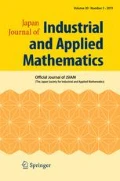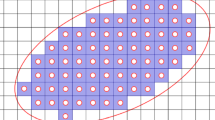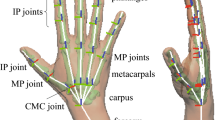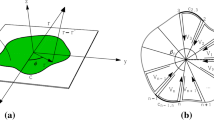Abstract
This paper describes the shape optimization of an electrostatic capacitive sensor used to detect fingers. We consider two state determination problems. The first is a basic electrostatic field problem consisting of sensing electrodes, an earth electrode, and air. The second is an electrostatic field problem in which fingers are added to the basic electrostatic field problem. An objective cost function is defined using the negative-signed squared \(H^{1}\)-norm of the difference between the solutions of the two state determination problems. The volume of the sensing electrode is used as the cost function. Using the solutions of the two state determination problems and the two adjoint problems, we present a method for evaluating the shape derivative of the objective cost function. To solve the shape optimization problem and minimize the negative-signed difference norm under the volume constraint, we use an iterative algorithm based on the \(H^{1}\) gradient method. An algorithm for the shape optimization problem is developed to solve the boundary value problems. Numerical examples show that reasonable shapes are obtained using the present approach.


















Similar content being viewed by others
References
Azegami, H.: A solution to domain optimization problems. Trans. Jpn. Soc. Mech. Eng. Ser. A 60, 1479–1486 (1994). (In Japanese)
Azegami, H.: Regularized solution to shape optimization problem (in Japanese). Trans. JSIAM 24(2), 83–138 (2014)
Azegami, H., Fukumoto, S., Aoyama, T.: Shape optimization of continua using nurbs as basis functions. Struct. Multidiscip. Optim. 47(2), 247–258 (2013)
Azegami, H., Kaizu, S., Takeuchi, K.: Regular solution to topology optimization problems of continua. JSIAM Lett. 3, 1–4 (2011)
Azegami, H., Ohtsuka, K., Kimura, M.: Shape derivative of cost function for singular point: evaluation by the generalized j integral. JSIAM Lett. 6, 29–32 (2014). doi:10.14495/jsiaml.6.29
Azegami, H., Takeuchi, K.: A smoothing method for shape optimization: traction method using the Robin condition. Int. J. Comput. Methods 3(1), 21–33 (2006)
Azegami, H., Zhou, L., Umemura, K., Kondo, N.: Shape optimization for a link mechanism. Struct. Multidiscip. Optim. (2013). doi:10.1007/s00158-013-0886-9
Crescini, D., Ferrari, V., Marioli, D., Taroni, A.: A thick-film capacitive pressure sensor with improved linearity due to electrode-shaping and frequency conversion. Meas. Sci. Technol. 8(1), 71 (1997). http://stacks.iop.org/0957-0233/8/i=1/a=010
Davison, B.: Techniques for robust touch sensing design. Application Note 1334, Microchip Technology Inc. (2010). http://ww1.microchip.com/downloads/en/AppNotes/00001334B.pdf
Du, L., Kwon, G., Arai, F., Fukuda, T., Itoigawa, K., Tukahara, Y.: Structure design of micro touch sensor array. Sens. Actuators A Phys. 107(1), 7–13 (2003). doi:10.1016/S0924-4247(03)00105-5. http://www.sciencedirect.com/science/article/pii/S0924424703001055
Kim, Y.S., Byun, J.K., Park, I.H.: A level set method for shape optimization of electromagnetic systems. Magn. IEEE Tran 45(3), 1466–1469 (2009). doi:10.1109/TMAG.2009.2012681
Kimura, M.: Shape derivative of minimum potential energy: abstract theory and applications. Jindřich Nečas Center for Mathematical Modeling Lecture notes Volume IV, Topics in Mathematical Modeling, pp. 1–38 (2008)
Voorthuyzen, J.A., Sprenkels, A.J., van der Donk, A.G.H., Scheeper, P.R., Bergveld, P.: Optimization of capactive microphone and pressure sensor performance by capacitor–electrode shaping. Sens. Actuators A 25–27, 331–336 (1991)
Author information
Authors and Affiliations
Corresponding author
Appendix A: Formula of shape derivative
Appendix A: Formula of shape derivative
In Sect. 6, the following formula is used [2, p. 96 Proposition 4.4].
Proposition 1
(Shape derivative of domain integral) Let \(\varvec{\phi } \in \mathcal {D}\), \(u \in \mathcal {U} = C^1 \left( \mathcal {D} ; H^1 \left( \mathbb {R}^d ; \mathbb {R} \right) \right) \), \(\varvec{\nabla } u \in \mathcal {V} = C^1 \left( \mathcal {D} ; L^2 \left( \mathbb {R}^d ; \mathbb {R}^d \right) \right) \), and \(h \left( u, \varvec{\nabla } u \right) \in C^1 \left( \mathcal {U} \times \mathcal {V} ; L^2 \left( \mathbb {R}^d ; \mathbb {R} \right) \right) \). Writing \(\varvec{z} = \varvec{x} + \varvec{\varphi } \left( \varvec{x} \right) \), let
for an arbitrary \(\varvec{\varphi } \in {\mathcal {D}}\). Then, the shape derivative (Fréchet derivative with respect to domain variation) of f is given by
where \(u^\prime \left( \varvec{\phi } \right) \left[ \varvec{\varphi } \right] \) is the shape derivative of \(u \left( \varvec{\phi } \right) \) with respect to \(\varvec{\varphi } \in {\mathcal {D}}\).
About this article
Cite this article
Satake, M., Maeda, N., Fukui, S. et al. Shape optimization of an electrostatic capacitive sensor. Japan J. Indust. Appl. Math. 33, 599–619 (2016). https://doi.org/10.1007/s13160-016-0234-8
Received:
Revised:
Published:
Issue Date:
DOI: https://doi.org/10.1007/s13160-016-0234-8
Keywords
- Shape optimization
- Electromagnetics
- Electrostatic capacitive sensor
- Shape derivative
- \(H^{1}\) gradient method




